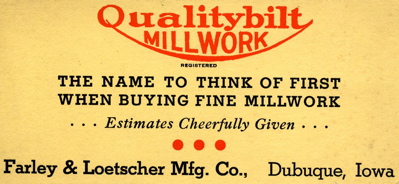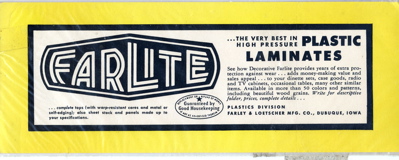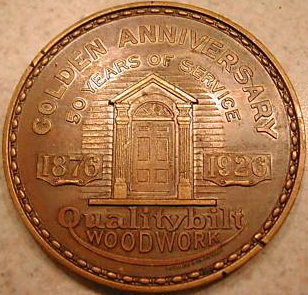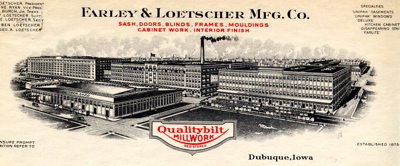Encyclopedia Dubuque
"Encyclopedia Dubuque is the online authority for all things Dubuque, written by the people who know the city best.”
Marshall Cohen—researcher and producer, CNN
Affiliated with the Local History Network of the State Historical Society of Iowa, and the Iowa Museum Association.
FARLEY AND LOETSCHER MANUFACTURING COMPANY: Difference between revisions
No edit summary |
No edit summary |
||
| Line 1: | Line 1: | ||
[[Image:farleyloetscher.gif|left|thumb|350px|Farley and Loetscher produced the nationally recognized "Qualitybilt" brand.]] | [[Image:farleyloetscher.gif|left|thumb|350px|Farley and Loetscher produced the nationally recognized "Qualitybilt" brand.]] | ||
[[Image:circa.jpg|right|thumb|250px|Advertisement. Photo courtesy: William K. Hammel]]FARLEY AND LOETSCHER MANUFACTURING COMPANY. Once the largest mill working | [[Image:circa.jpg|right|thumb|250px|Advertisement. Photo courtesy: William K. Hammel]]FARLEY AND LOETSCHER MANUFACTURING COMPANY. Once the largest mill working plants in the world. Farley and Loetscher began humbly in 1875 when [[LOETSCHER, Christian|Christian LOETSCHER]], a twenty-five-year-old Swiss immigrant, opened a mill working business. | ||
The firm, with only Loetscher as an employee, operated from a 16- by 20-foot second floor space leased from the Key City Mill. | The firm, with only Loetscher as an employee, operated from a 16- by 20-foot second floor space leased from the Key City Mill. In 1876 Loetscher formed a partnership with A. B. Carlin and J. Rickard. The company, renamed Clark, Rickard and Company, bought the Key City Planing Company and remained a small millwork factory. | ||
In 1876 Loetscher formed a partnership with A. B. Carlin and J. Rickard. The company, renamed Clark, Rickard and Company, bought the Key City Planing Company and remained a small millwork factory. | |||
[[Image:farley.jpg|left|thumb|350px|Alexander Simplot illustration from the ''Dubuque Trade Journal'' of September 20, 1882 shows the Key City Mill still visible on the building. Photo courtesy: Bob Reding]][[FARLEY, Jesse P.|Jesse P. FARLEY]] became the principal partner in the company in 1879 by investing $75,000 in a three-story building at Eighth and Jackson [[STREETS]]. In 1881 the company was incorporated as the Farley and Loetscher Manufacturing Company. Farley served as president. | [[Image:farley.jpg|left|thumb|350px|Alexander Simplot illustration from the ''Dubuque Trade Journal'' of September 20, 1882 shows the Key City Mill still visible on the building. Photo courtesy: Bob Reding]][[FARLEY, Jesse P.|Jesse P. FARLEY]] became the principal partner in the company in 1879 by investing $75,000 in a three-story building at Eighth and Jackson [[STREETS]]. In 1881 the company was incorporated as the Farley and Loetscher Manufacturing Company. Farley served as president. | ||
Revision as of 03:24, 25 February 2010
FARLEY AND LOETSCHER MANUFACTURING COMPANY. Once the largest mill working plants in the world. Farley and Loetscher began humbly in 1875 when Christian LOETSCHER, a twenty-five-year-old Swiss immigrant, opened a mill working business.
The firm, with only Loetscher as an employee, operated from a 16- by 20-foot second floor space leased from the Key City Mill. In 1876 Loetscher formed a partnership with A. B. Carlin and J. Rickard. The company, renamed Clark, Rickard and Company, bought the Key City Planing Company and remained a small millwork factory.
Jesse P. FARLEY became the principal partner in the company in 1879 by investing $75,000 in a three-story building at Eighth and Jackson STREETS. In 1881 the company was incorporated as the Farley and Loetscher Manufacturing Company. Farley served as president.
Loetscher pioneered the use of west coast white pine lumber in 1900 as the company branched out to markets around St. Louis, Missouri; Chicago, Illinois; Sioux Falls, South Dakota; and Des Moines, Iowa. The "Qualitybilt" brand of sash and doors became nationally recognized. By 1927, when the company was led by J. A. Loetscher, Christian's son, the firm occupied buildings covering twenty-three acres.
A line of laminated plastics used for decorative and industrial uses was added to the company's products in the early 1930s. This production once occupied three acres of floor space. Employment peaked at 1,250 and dropped to five hundred prior to 1960 when Clear Fir Sales Company, a trust headed by W. H. Gonyea of Springfield, Oregon, purchased the company. Unprofitable items and overhead were slashed to improve the company's profitability.
In July 1960, Farley and Loetscher announced the sale of its plastics manufacturing facilities to Durel, Inc., a subsidiary of CARADCO. Two years later, the company announced that it would close on or about February 28, 1962. Cited as causes were rapidly increasing wage rates and low prices for millwork.
At the time of its closing, Farley and Loetscher was the third largest employer in Dubuque. Among the reminders of the company was the building bounded by Seventh, Eighth, Washington and Jackson Streets. At one time described as the largest lumber shed in the world, the structure was the largest building in Dubuque until the development of the JOHN DEERE DUBUQUE WORKS. It was estimated that the building could hold ten million feet of lumber or the equivalent of 250 boxcar loads. Christian Loetscher while attending the St. Louis Exposition in 1904 bought forty huge timbers when the exhibition buildings were being dismantled. These timbers, each 13 by 11 inches and up to sixty feet in length, were used in the construction of the building. Thirty-two were placed around the perimeter of the cupola while eight were spaced at intervals along the center of the building. (Photo Courtesy: http://www.dubuquepostcards.com)








